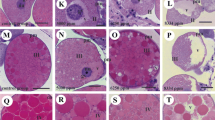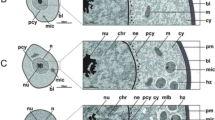Abstract
Given the wide use of synthetic chemicals to control ticks, this study evaluated the effects of the permethrin pyrethroid on oocytes of Rhipicephalus sanguineus fully engorged females in order to examine whether this compound, in addition to the proven neurotoxic effect, also acts directly on germ cells. The results revealed that permethrin effectively inhibits and/or interrupts the reproductive process of R. sanguineus. Exposed oocytes exhibited prominent structural changes such as altered shape of cells and germ vesicle (oocyte nucleus), cytoplasmic vacuolation, and decrease of yolk granules. The composition of the latter, however, was not altered. These findings confirm those already reported by Roma et al. (Food Chem Toxicol 48:825–830, 2010) demonstrating that permethrin acts on germ cells of R. sanguineus via direct absorption from the hemolymph by pedicel cells, or by the oocyte plasmic membrane. On the other hand, these results contradict studies reporting that acaricides act exclusively on the nervous systems of ticks and that all the changes in other organs are a result from the indirect action of these chemical compounds, because blocking of the nervous system would compromise the normal metabolism of other organs (dependent on sensory information).


Similar content being viewed by others
References
Bechara GH, Szabó MPJ, Ferreira BR, Garcia MV (1995) Rhipicephalus sanguineus tick in Brazil: feeding and reproductive aspects under laboratorial conditions. Braz J Vet Parasitol 4:61–66
Brinton LP, Oliver JH (1971) Fine structure of oogonial and oocytes development in Dermacentor andersoni Stile (Acari: Ixodidae). J Parasitol 57:720–747
Denardi SE, Bechara GH, Oliveira PR, Nunes ET, Saito KC, Camargo-Mathias MI (2004) Morphological characterization of the ovary and vitellogenesis dynamics in the tick Amblyomma cajennense (Acari: Ixodidae). Vet Parasitol 125:379–395
Denardi SE, Bechara GH, Oliveira PR, Camargo-Mathias MI (2010) Azadirachta indica A. Juss (neem) induced morphological changes on oocytes of Rhipicephalus sanguineus (Latreille, 1806) (Acari: Ixodidae) tick females. Exp Parasitol. doi:10.1016/j.exppara.2010.05.017
Diehl PA (1970) Zur oogenese bei Ornithodoros moubata (Murray) (Ixodoidea: Argasidae) unter besonderer berücksichtigung der vitellogenese. Acta Trop 27:301–355
Dong K (2007) Insect sodium channels and insecticide resistance. Invert Neurosci 7:17–30
Friesen KJ, Kaufman WR (2009) Salivary gland degeneration and vitellogenesis in the ixodid tick Amblyomma hebraeum: surpassing a critical weight is the prerequisite and detachment from the host is the trigger. J Insect Physiol 55:936–942
Furquim KCS, Bechara GH, Camargo-Mathias MI (2008a) Cytoplasmic RNA and nuclear changes detected cytochemically during the degeneration of salivary glands of the tick Rhipicephalus sanguineus (Latreille, 1806) (Acari, Ixodidae). Micron 39:960–966
Furquim KCS, Bechara GH, Camargo-Mathias MI (2008b) Death by apoptosis in salivary glands of females of the tick Rhipicephalus sanguineus (Latreille, 1806) (Acari: Ixodidae). Exp Parasitol 119:152–163
Furquim KCS, Bechara GH, Camargo-Mathias MI (2008c) Degeneration of salivary glands of males of the tick Rhipicephalus sanguineus (Latreille, 1806) (Acari, Ixodidae). Vet Parasitol 154:325–335
Furquim KCS, Bechara GH, Camargo-Mathias MI (2010) Morpho-histochemical characterization of salivary gland cells of males of the tick Rhipicephalus sanguineus (Latreille, 1806) (Acari, Ixodidae) at different feeding stages: description of new cell types. Exp Appl Acarol 50:59–70
Hinton HE (1982) Biology of Insect Egg Shells. Pergamon, Oxford
Kaufman WR (1989) Tick–host interaction: a synthesis of current concepts. Parasitol Today 5:47–56
Kelly EAB, Colley DG (1988) In vivo effects of monoclonal anti-13t4 antibody on immune responsiveness of mice infected with Schistosoma mansoni—reduction of irradiated cercariae-induced resistance. J Immunol 140:2737–2745
Labruna MB (2004) Biologia–ecologia de Rhipicephalus sanguineus (Acari: Ixodidae). Rev Bras Parasitol Vet 13:123–124
Leal AT, Freitas DRJ, Vaz IS (2003) Perspectives for control of bovine tick. Acta Sci Vet 31:1–11
Lomas LO, Kaufman WR (1992a) The influence of a factor from the male genital tract on salivary gland degeneration in the female ixodid tick Amblyomma hebraeum. J Insect Physiol 38:595–601
Lomas LO, Kaufman WR (1992b) An indirect mechanism by which a protein from the male gonad hastens salivary gland degeneration in the female ixodid tick, Amblyomma hebraeum. Arch Insect Biochem Physiol 21:169–178
Mencke N, Volp P, Volfova V, Stanneck D (2003) Repellent efficacy of a combination containing imidacloroprid and permethrin against sand flies (Phlebotomus papatasi) on dogs. Parasitol Res 90:108–111
Nunes ET, Camargo-Mathias MI, Bechara GH (2006) Structural and cytochemical changes in the salivary glands of Rhipicephalus (Boophilus) microplus (Canestrini, 1887) (Acari: Ixodidae) tick female during feeding. Vet Parasitol 140:114–123
Nunes PH, Bechara GH, Camargo-Mathias MI (2008) Morphological changes in the salivary glands of Amblyomma cajennense females (Acari: Ixodidae) in different feeding stages on rabbits at first infestation. Exp Appl Acarol 45:199–209
Oliveira PR, Bechara GH, Denardi SE, Nunes ET, Camargo-Mathias MI (2005) Morphological characterization of the ovary and oocytes vitellogenesis of the tick Rhipicephalus sanguineus (Latreille, 1806) (Acari: Ixodidae). Exp Parasitol 110:146–156
Oliveira PR, Camargo-Mathias MI, Bechara GH (2006) Amblyomma triste (Koch, 1884) (Acari: Ixodidae): morphological description of the ovary and of vitellogenesis. Exp Parasitol 113:179–185
Oliveira PR, Camargo-Mathias MI, Bechara GH (2007) Vitellogenesis in the tick Amblyomma triste (Koch, 1844) (Acari: Ixodidae). Role for pedicel cells. Vet Parasitol 143:134–139
Oliveira PR, Bechara GH, Camargo-Mathias MI (2008) Evaluation of cytotoxic effects of fipronil on ovaries of semi-engorged Rhipicephalus sanguineus (Latreille, 1806) (Acari: Ixodidae) tick female. Food Chem Toxicol 46:2459–2465
Oliveira PR, Bechara GH, Marin-Morales MA, Camargo-Mathias MI (2009) Action of the chemical agent fipronil on the reproductive process of semi-engorged females of the tick Rhipicephalus sanguineus (Latreille, 1806) (Acari: Ixodidae). Ultrastructural evaluation of ovary cells. Food Chem Toxicol 47:1255–1264
Pearse AGE (1985) Histochemistry: theoretical and applied. Churchill, London
Pereira CPM, Oliveira PR, Furquim KCS, Bechara GH, Camargo-Mathias MI (2009) Effects of fipronil (active ingredient of Frontline®) on salivary gland cells of Rhipicephalus sanguineus females (Latreille, 1806) (Acari: Ixodidae). Vet Parasitol 166:124–130
Proskuryakov SY, Konoplyannikov AG, Gabai VL (2003) Necrosis: a specific form of programmed cell death? Exp Cell Res 283:1–16
Roma GC, Oliveira PR, Pizano MA, Camargo-Mathias MI (2009) Determination of LC50 of permethrin acaricide in semi-engorged females of the tick Rhipicephalus sanguineus (Latreille, 1806) (Acari: Ixodidae). Exp Parasitol 123:269–272
Roma GC, Furquim KCS, Bechara GH, Camargo-Mathias MI (2010) Permethrin-induced morphological changes in oocytes of Rhipicephalus sanguineus (Acari: Ixodidae) semi-engorged females. Food Chem Toxicol 48:825–830
Saito KC, Bechara GH, Nunes ET, Oliveira PR, Denardi SE, Camargo-Mathias MI (2005) Morphological, histological, and ultrastructural studies of the ovary of the cattletick Boophilus microplus (Canestrini, 1887) (Acari: Ixodidae). Vet Parasitol 129:299–311
Weiss LB, Kaufman WR (2001) The relationship between ‘critical weight’ and 20-hydroxiecdysone in the female ixodid tick, Amblyomma hebraeum. J Insect Physiol 47:1261–1267
Acknowledgments
Authors are grateful to the Fundação de Amparo à Pesquisa do Estado de São Paulo—FAPESP (Grant nos. 07/57809-5 and 07/59020-0) and to the Conselho Nacional de Desenvolvimento Científico e Tecnológico—CNPq (Grant no. 308733/2006-1 and G.H. Bechara and M.I. Camargo Mathias academic carrier research fellowships) for the financial support and to Mr. Gérson de Mello Sousa for technical support.
Author information
Authors and Affiliations
Corresponding author
Rights and permissions
About this article
Cite this article
Roma, G.C., Furquim, K.C.S., Bechara, G.H. et al. Cytotoxic effects of permethrin in oocytes of Rhipicephalus sanguineus (Acari: Ixodidae) fully engorged females: I. Direct or indirect action of the acaricide in germ cells?. Exp Appl Acarol 53, 287–299 (2011). https://doi.org/10.1007/s10493-010-9401-9
Received:
Accepted:
Published:
Issue Date:
DOI: https://doi.org/10.1007/s10493-010-9401-9




